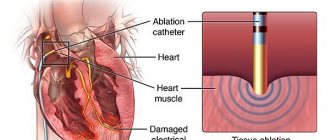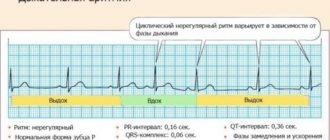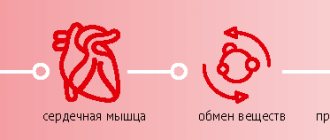Pharmacological properties of the drug Validol
The drug has a calming effect on the central nervous system, and also has a moderate reflex vasodilator (coronary lytic) effect due to reflex irritation of sensitive nerve (“cold”) receptors of the oral mucosa. Stimulation of receptors is accompanied by the induction of the release of endorphins, enkephalins, dynorphins and other opioid peptides, which play an important role in reducing pain, normalizing vascular permeability and regulating other important mechanisms of functioning of the cardiovascular and nervous systems. Under the influence of the drug, physiologically active substances are released - histamines, kinins, etc. When administered sublingually, the drug is absorbed from the oral mucosa. The therapeutic effect occurs in approximately 5 minutes. After absorption, it is biotransformed in the liver and excreted in the urine in the form of glucuronides.
Side effects and symptoms of overdose
With long-term use, the following side effects may occur:
feelings of nausea;- tearfulness;
- feelings of loss of orientation in space and dizziness;
- low blood pressure (hypotension is transient);
- drowsiness;
- increased flatulence (discharge of intestinal gases);
- allergic reactions (Quincke's edema, rash on the skin and mucous membranes, itching).
After stopping taking Validol, the symptoms quickly disappear on their own.
Symptoms of exceeding the dose of this medication are a clear manifestation of side effects in combination with nervous excitement, cardiac dysfunction, a drop in blood pressure and depression of the functions of the central nervous system.
In case of overdose and symptoms of poisoning occur, it is necessary to immediately discontinue the drug, organize gastric lavage and administer desensitizing agents.
Use of the drug Validol
Tablets Adults are prescribed 1 tablet under the tongue until completely absorbed. The frequency and duration of taking the drug are determined taking into account the therapeutic effectiveness. Drops 4-5 drops of Validol solution are applied to a piece of sugar and kept in the mouth until completely absorbed. Locally, 5–10% alcohol solution of Validol is used for itchy skin. Capsules Adults are prescribed sublingual 1 capsule (100 mg). The capsule is kept under the tongue until completely dissolved. To speed up the effect, the capsule can be bitten. The dose and duration of use are determined depending on the therapeutic effect. The maximum daily dose is 600 mg. In the absence or insufficient severity of the therapeutic effect within 5–10 minutes after administration, it is necessary to prescribe another therapy.
Indications for use
Validol is prescribed if the following indications exist:
functional cardialgia (in the absence of a morphological substrate for damage to the heart muscle and pronounced myocardial hypertrophy);- angina pectoris of an angioedema nature (accompanied by increased heartbeat);
- mild forms of coronary heart disease (as one of the components of complex therapy);
- neuroses (accompanied by tachycardia due to stress);
- attacks of hysteria (as a sedative and to reduce heart rate - HR);
- exposure to attacks of “sea” and “air” sickness (in the case when it has a neuropsychological origin);
- headache (caused by taking nitrates, such as nitroglycerin).
Even if a person finds indications for the use of Validol, this is not a sufficient reason to take the medication. Specialist consultation is required.
A contraindication for the use of Validol is the lack of individual compatibility and intolerance to any of its components.
Features of use for concomitant pathologies
for headaches caused by the use of nitrates (they provoke dilation of intracranial vessels and, accordingly, a local increase in pressure), Validol successfully helps;- this drug enhances the sedative effect of psychotropic drugs (there is a danger of developing apatho-abulic disorders), opiates (a possible fatal complication is depression of the respiratory center until breathing stops completely), anesthesia (there is a risk of transition to a coma);
- in the presence of a hangover, taking Validol will significantly aggravate the existing symptoms;
- Validol has the ability to lower blood pressure (due to its calming and vasodilating effects), but it should not be used to prevent hypertensive crises;
- if the patient receives drug therapy for hypertension, it is necessary to take into account the ability of Validol to potentiate the effect of antihypertensive drugs (there is a danger of iatrogenic hypotension - a provoked decrease in pressure);
- during pregnancy, the drug can be used after consultation with a doctor in the case when the expected positive effect exceeds the possible negative effect of the drug on the fetus;
- During lactation, Validol can be used, but with caution, since active release of this medication into milk is not observed during feeding, but extensive clinical studies have not been conducted;
- Alcohol and Valocordin are not compatible.
Alcohol initially has a dilating effect on the blood vessels, but eventually they spasm. Such a sharp change in the tone of the walls of arterioles and venules can provoke an attack of arrhythmia. During heavy drinking, frequent changes in the volume of the bloodstream can lead to serious consequences (stroke, asystole - lack of pulse).
conclusions
Validol is a menthol-based drug that has been prescribed by therapists and cardiologists for decades. Modern experts question its effectiveness, comparing it with placebo.
Validol does not have a pronounced effect, and as a preventive measure for increasing the area of necrosis during myocardial infarction, it will be ineffective. However, in case of minor functional disorders of the heart caused by overstrain of the nervous system, this drug has the necessary sedative and vasodilating effect in sufficient quantities.
Analogues of Validol: Corvalment, Lily of the valley-valerian drops.
Validol. From the 19th century to the present day
Validol
(lat.
Validol
, English
validolum
or
menthyl isovalerate
) - a weak sedative and reflective vasodilator.
In the USSR and Russia it is widely used by citizens without medical education for pain in the heart area. Its effectiveness has not been confirmed by evidence-based medicine and largely comes down to the placebo effect. For more than a hundred years of history, validol
has managed to be both a remedy for the treatment of the stomach and a medicine prescribed for neuroses and hysteria. 10 years ago it was recognized as a medicine with unproven effectiveness, but is still sold in pharmacies and is widely used by the population for heart pain.
The appearance of validol in Russia
For the first time they learned about validol in Russia from a message by V.F. Sprimon, published in December 1897 in the journal “Medical Review of Sprimon”, which he published, in which he uncritically presented the information he gleaned from the article “Validol, a revitalizing and antihysterical remedy” by the Berlin doctor Georg Schwersenski (G. Schwersenski. Validol, ein Analepticum und Antihystericum // Therapeut. Monatsh. 1897, No. 11):
Validol
is a chemical compound of menthol and valeric acid. It is a clear, colorless liquid with the consistency of glycerin, a pleasant, delicate odor and a slightly cooling taste. It has the property of dissolving significant amounts of pure menthol and depriving it of its inherent irritating properties. Validol, as an analeptic, represents the effect of both of its constituent agents, but does not produce, like the latter taken separately, any local irritation on the mucous membranes. 10-15 drops of validol have a highly stimulating effect on hysterical and neurasthenic people. This dose can be repeated up to 3 times a day if necessary. Validol also acts as a good remedy for stomach pain, stimulates appetite, eliminates nausea, pressure and pain in the pit of the stomach. At the same time, it is an effective carminative (10-15 drops in sugar or wine).Externally, validol works well in the initial stages of catarrh of the respiratory tract, if you inhale it, pour a few drops into the palm of your hand, and also lubricate the tonsils and pharynx with it.
Since the bactericidal properties of menthol are superior to those of carbolic acid, validol is a good disinfectant for the skin*).
V.F. Sprimon
————————— *) Validol, recently prepared by the Zimmer and Co. factory, contains 30% free menthol.
Thus, in this publication, validol was presented as a cure for almost all diseases.
In Germany, validol has been popular for about 30 years. When writing this section, the publication material was used: N.P. Arzhanov. Validol: strangeness of fate. Magazine “Treatment in Germany” No. 10.
Validol - a remedy for treating the stomach
As a pre-revolutionary advertisement says: “
Validol is an excellent, doctor-tested remedy
against stomach ailments
.
It is a combined compound of valeric acid and menthol .
Most likely, the effect of validol “against gastric ailments” is associated with its sedative qualities. The difference between the composition of pre-revolutionary validol and modern one is perhaps only terminological. In those days, the isomer of valeric acid, isovaleric acid, could also be called valeric acid. This is evidenced in particular by the fact that in the Brockhaus and Efron Encyclopedic Dictionary, isovaleric acid is described in the article “Valeric acid” (vol. V, 1881).
Is Validol an outdated drug with unproven effectiveness?
The Presidium of the Formulary Committee of the Russian Academy of Medical Sciences, in its Resolution dated March 16, 2007, Fr.
10 years after the appearance of this Resolution, the State Register of Medicines of the Russian Federation lists several dozen valid licenses for medicines with the trade names “Validol” and “Validol with glucose” from different manufacturers.
Modern ideas about validol
In modern validol, according to entries in the State Register of Medicines of the Russian Federation, the active substance is levomenthol (or menthol) solution in menthyl isovalerate (in other words, in the menthyl ester of isovaleric acid).
Validol release form
: sublingual tablets, sublingual tablets, capsules.
Previously, Validol was also produced in the form of drops for oral administration. Indications for use of validol
- functional cardialgia
- relief of angina attacks
- neuroses
- hysteria
- nausea and vomiting due to seasickness and air sickness
Procedure for taking validol and dose.
Take one Validol tablet sublingually (under the tongue). The maximum daily dose is 0.2 g.
Side effects of validol.
Mild nausea, lacrimation, dizziness, which go away on their own.
According to ATX, validol belongs to “Section C. Drugs for the treatment of diseases of the cardiovascular system” and has the code “C01EX Other combined drugs for the treatment of heart diseases.”
Validol is in no way an alternative to nitroglycerin. It has contraindications, side effects and features of use; if used, consultation with a specialist is recommended.
Back to section








